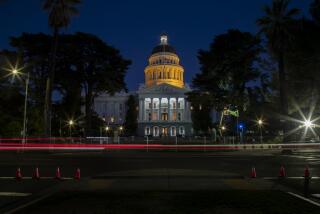Opinion: After-school special: the Satan Club
- Share via
My first reaction to the news that the Satanic Temple hopes to establish after-school “Satan Clubs” at elementary schools was to crack a joke -- actually two.
Joke 1: Most of the kids who sign up for the Satan Club will do it just to pad their yearbook mentions.
Joke 2: Inspired by Donald Trump’s description of Hillary Clinton as “the devil,” kids in the Satan Club will make campaign posters for the Democratic nominee.
But the prospect of Satan Clubs at public schools isn’t only a laughing matter. As two Washington Post reporters discovered, several school administrators believe that such clubs would probably conform to their policies for after-school organizations. One school district in Prince George’s County, Md., is reviewing a request for the establishment of such a club.
Congress seemingly has left high schools no choice. The Equal Access Act, passed by Congress in 1984, prohibits public secondary schools receiving federal funds -- that is, virtually all of them -- from discriminating against student clubs on the basis of the “religious, political, philosophical, or other content of the speech at such meetings.” The Supreme Court upheld the law in 1990.
A school doesn’t have to establish what the court called a “limited open forum,” but once it does, it can’t discriminate on the basis of viewpoint. That also tracks the Supreme Court’s interpretation of the 1st Amendment, which applies to elementary as well as secondary schools. (In 2001 the Supreme Court ruled in a New York case that a school district violated the Constitution when it excluded a Good News Club from meeting after hours at a school.)
So do schools really have to let little Satanists meet? That “wait, what?” question is probably on the lips of lots of Americans, and not just devout Christians or Donald Trump supporters who believe that his election will revive the practice of wishing “Merry Christmas.”
The answer is basically yes, and would probably be yes even if kids in the Satan Clubs formed a circle and chanted, “Hail, Satan!” But human or even animal sacrifice would probably be prohibited under an exception in the Equal Access Act for meetings that “materially and substantially interfere with the orderly conduct of educational activities within the school.” (In fact, the Satanic Temple isn’t in the blood sacrifice business; here’s a primer on the group by my colleague Robin Abcarian.)
Meetings of the Satan Clubs would focus on teaching reason and science. That would be consistent with the Satanic Temple’s mission statement, which doesn’t mention worshiping the Dark One (although he’s pictured on its website). Instead, the group says its goal is “to encourage benevolence and empathy among all people, reject tyrannical authority, advocate practical common sense and justice, and be directed by the human conscience to undertake noble pursuits guided by the individual will.”
As for the Satan Clubs -- promoted on the website as “Educatin’ with Satan” -- they seem to be primarily a form of counter-programming for Good News Clubs. “It’s important,” the Satanic Temple explains, “that children be given an opportunity to realize that the evangelical materials now creeping into their schools are representative of but one religious opinion among many.”
Even a few years ago, the notion that an atheist or humanist club -- let alone one named after Satan -- would be allowed to meet at a public school would have caused a national outcry, and politicians would join in the chorus of condemnation.
But times have changed. In his 2009 inaugural address, President Obama said: “We are a nation of Christians and Muslims, Jews and Hindus, and non-believers.“ Granted, Obama didn’t mention Satanists of either the serious or the satirical sort. But the principle’s the same.
Follow the Opinion section on Twitter @latimesopinion and Facebook
MORE FROM OPINION
Motive is irrelevant when states make it harder for minorities to vote
Should we care about Hillary Clinton’s ‘historic’ candidacy?
L.A. isn’t a suburb. We need to stop planning it like one.
More to Read
A cure for the common opinion
Get thought-provoking perspectives with our weekly newsletter.
You may occasionally receive promotional content from the Los Angeles Times.










